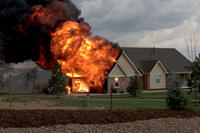-
A first: Engineering students design firefighting humanoid robot
In fall 2014 in Mobile Bay, Alabama, Virginia Tech engineering students made history during a five-minute demo that placed an adult-sized humanoid robot with a hose in front of a live fire aboard a U.S. Navy ship. The robot located the fire and sprayed water from the hose. Water blasted the flames. The demo, four years in the making, is part of a new effort by the U.S. Navy better to assist sailors in fighting fires, controlling damage, and carrying out inspections aboard ships via user-controlled unmanned craft or humanoid robots.
-
-
Faster first aid for catastrophe victims
In mass casualty incidents, triage of the victims must be performed as quickly as possible, in order to evacuate and take them to appropriate hospitals. Today, first responders use colored paper tags to classify victims. Researchers have developed an electronic gadget that may replace the colored paper tags in a triage. Beyond just visually tagging a victim, the device transmits, in real time, the victim’s location and vital data, for example, heart rate, respiratory rate, and oxygen saturation, to emergency response control centers.
-
-
Modeling study reveals the lethal dynamics of a San Francisco house fire
A new computer-based fire-dynamics study by researchers at the National Institute of Standards and Technology (NIST) has helped to clarify the circumstances and violent fire behavior of a lethal 2011 blaze in a San Francisco hillside home. The fire in the multi-story, single-family dwelling claimed the lives of two firefighters.
-
-
Drawing disaster response lessons by comparing quake responses
Following the devastating 2011 Great East Japan Earthquake which hit the Tohoku region of Japan, many local and provincial governments rushed to aid the people in the area with personnel and materials, providing important relief in a time of crisis. At a recent symposium, some were comparing the response to the 2011 disaster to the response to the Great Hanshin-Awaji Earthquake of 1995 in order to draw lessons and offer guidelines in effective crisis management.
-
-
DHS S&T makes it easier and cheaper for first responders to communicate
A new low-cost interoperability solution developed by the Department of Homeland Security (DHS) Science and Technology Directorate (S&T) could save the first responder community millions of dollars.
S&T says that the Radio Internet Protocol Communications Module (RIC-M), used by local, state, and federal responders, is a low-cost, external, stand-alone, interface device that connects radio frequency (RF) system base stations, consoles and other RF equipment — regardless of brand — over the Internet or Private Internet Protocol (IP) network.
-
-
Realistic radiation detection training without using radioactive materials
Training of first responders on the hazards of actual radiological and nuclear threats has been challenged by the difficulties of adequately representing those threats. Training against such threats would involve using hazardous, highly radioactive materials, experiencing actual radiation doses in training, or require the distribution of radioactive material over a large geographical area. To avoid these issues in exercises to train responders, surrogate radioactive materials have been used, but these materials do not completely represent real threats due to their non-hazardous size and inability to be geographically distributed. Researchers have solved the problem by developing a new technology that provides realistic radiation detection training by directly injecting simulated radiation signals into the analog amplifier of the real detectors used by first responders and inspectors.
-
-
Mobile app helps first responders choose the right biodetection technology
First responders have downloaded more than 10,000 copies of a guide to commercially available, hand-portable biodetection technologies created to help them determine what they might be up against in the field. Since many first responders do not always have immediate access to a computer, a mobile version of the guide is now available for cell phones and tablets. An updated version of the guide has just been released to help response organizations make informed decisions when procuring the right technology for their particular needs and circumstances.
-
-
Nanomaterial proves to be a better flame retardant than chemical alternative
In a face-off between two promising flame retardants, the challenger — a nanomaterial that maintains a positive façade while sheltering a negative interior — outperformed its chemical antithesis. This material already is a leading candidate for environmentally friendly fire-resistant coatings on furniture foam.
-
-
Washington State seeks better responses to landslides
The March 2014 Oso landslide in Snohomish County, Washington State, killed forty-three people. A state commission, including experts in emergency management, land planning and development, geology, and hydrology, appointed by Washington state governor Jay Inslee to determine how better to avoid and respond to landslides released seventeen recommendations on last Monday.
-
-
Be prepared: What to do if an asteroid is heading our way

Last month, experts from European Space Agency’s (ESA) Space Situational Awareness (SSA) program and Europe’s national disaster response organizations met for a two-day exercise on what to do if an asteroid is ever found to be heading our way. The exercise considered the threat from an imaginary, but plausible, asteroid, initially thought to range in size from twelve meters to thirty-eight meters — spanning roughly the range between the 2013 Chelyabinsk airburst and the 1908 Tunguska event — and travelling at 12.5 km/s. Teams were challenged to decide what should happen at five critical points in time, focused on 30, 26, 5, and 3 days before and one hour after impact.
-
-
Helping first-response robots operate for longer periods
Through a project supported by the Defense Advanced Research Projects Agency (DARPA), Sandia Lab is developing technology which will dramatically improve the endurance of legged robots, helping them operate for long periods while performing the types of locomotion most relevant to disaster response scenarios. One of Sandia’s new robots which showcases this technology will be demonstrated at an exposition to be held in conjunction with the DARPA Robotics Challenge Finals next June.
-
-
Firefighters portable radios may fail at elevated temperatures
Firefighters rely on the radios to report their location and to communicate with other first responders as well as the incident command post or communications center. Performance problems with portable radios have been identified by the National Institute for Occupational Safety and Health as contributing factors in some firefighter fatalities. New test results from the National Institute of Standards and Technology (NIST) confirm that portable radios used by firefighters can fail to operate properly within fifteen minutes when exposed to temperatures that may be encountered during firefighting activities.
-
-
New report, video detail dynamics of deadly Chicago house fire

A new NIST computer-modeling study of a 2012 Chicago house fire reveals the conditions that unleashed a surge of searing gases, leading to the death of a veteran firefighter. The simulation shows that fire in a covered back porch caused a closed steel-faced, wood-framed door to crumble, releasing pressure and causing hot gases to pour into the adjoining hallway where the victim and another firefighter were advancing a fire hose. The coincidental timing of the responders’ “interior attack” and the door’s failure proved to be deadly. In less than five seconds, the flow of gases caused the hallway temperature to soar, from about 60 degrees Celsius (140 degrees Fahrenheit) to at least 260 degrees Celsius (500 degrees Fahrenheit), the study found.
-
-
Cockroach cyborgs use microphones to detect, trace sounds in collapsed buildings
Researchers have developed technology that allows cyborg cockroaches, or biobots, to pick up sounds with small microphones and seek out the source of the sound. The technology is designed to help emergency personnel find and rescue survivors in the aftermath of a disaster. The researchers have also developed technology that can be used as an “invisible fence” to keep the biobots in the disaster area. “In a collapsed building, sound is the best way to find survivors,” says one of the researchers.
-
-
Connecticut and Kansas implement next-gen 911 system
Connecticut and Kansas are both currently installing the next generation of 911 telephone systems (NG911) in different cycles, but both are seeing the added benefits of the evolved system.NG911 will allow both states to offer the services of up-to-the-second multimedia information, including cell phone texts and video, as responders rush to an emergency site.
-
- All
- Regional
- Water
- Biometrics
- Borders/Immig
- Business
- Cybersecurity
- Detection
- Disasters
- Government
- Infrastructure
- International
- Public health
- Public Safety
- Communication interoperabillity
- Emergency services
- Emergency medical services
- Fire
- First response
- IEDs
- Law Enforcement
- Law Enforcement Technology
- Military technology
- Nonlethal weapons
- Nuclear weapons
- Personal protection equipment
- Police
- Notification /alert systems
- Situational awareness
- Weapons systems
- Sci-Tech
- Sector Reports
- Surveillance
- Transportation
Advertising & Marketing: advertise@newswirepubs.com
Editorial: editor@newswirepubs.com
General: info@newswirepubs.com
2010-2011 © News Wire Publications, LLC News Wire Publications, LLC
220 Old Country Road | Suite 200 | Mineola | New York | 11501
Permissions and Policies
Editorial: editor@newswirepubs.com
General: info@newswirepubs.com
2010-2011 © News Wire Publications, LLC News Wire Publications, LLC
220 Old Country Road | Suite 200 | Mineola | New York | 11501
Permissions and Policies
